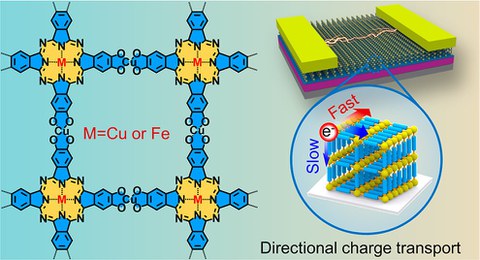26.08.2021
Interfacial Synthesis of Layer-Oriented 2D Conjugated Metal–Organic Framework Films toward Directional Charge Transport
Two-dimensional conjugated metal-organic frameworks (2D c-MOFs) have emerged as a unique class of electronic materials, because they displayed the potential as active layers for electronic devices due to high conductivities (up to 2500 S cm-1) and high carrier mobilities (up to 220 cm2 V-1 s-1) with band-like transport property as well as tunable electronic structures. In the previous reports, a great effort was devoted to exploring electronic properties via the intralayer (basal plane) pathway because it was believed that the high conductivity of 2D c-MOFs depended critically on the full π-electron delocalization in the 2D conjugated plane. However, recent advances demonstrated that long-range charge transport in these layer-stacked framework materials could be primarily mediated via π–π stacking order. Therefore, controlled synthesis of layer-oriented 2D c-MOF films will be highly desirable to direct the charge transport along the interlayer or intralayer pathways and dial-in lateral/vertical electronic devices as well as further unveil the transport mechanism. Nevertheless, such investigations have never been addressed so far due to the challenge in controlling the stacking orientation of 2D c-MOFs in thin films.
The researchers from Prof. Xinliang Feng and Dr. Renhao Dong’s group recently presents the first demonstration of synthesizing unprecedented edge-on layer-orientated p-type semiconducting 2D c-MOF films (Cu2[PcM-O8], M=Cu, Fe) by combining supramolecular chemistry and interface-assisted polymerization. They figure out the crystal structure and orientations of the 2D c-MOFs films with molecular precision, and demonstrate that the edge-on structure formation is guided by the pre-organization of metal-phthalocyanine ligands, whose basal plane is perpendicular to the water surface due to their π-π interaction and hydrophobicity. The synthetic Cu2[PcCu-O8] film features with a thickness of ~20 nm and ~600 nm-sized crystal domains, and exhibits a room temperature conductivity of ~5.6×10-4 S cm-1 and a Hall mobility of ~4.4 cm2 V-1 s-1 based on macroscopic van der Pauw pattern. Lateral and vertical measurements further reveal the directional charge transport feature in this edge-on 2D c-MOF film, i.e., the lateral conductivity is 2~3 orders of magnitude higher than the vertical one. The directional conductivity studies combined with theoretical calculation identify that the intrinsic conductivity of Cu2[PcCu-O8] is dominated by charge transfer along the interlayer pathway.
Reference: Z. Wang, L. S. Walter, M. Wang, P. S. Petkov, B. Liang, H. Qi, N. N. Nguyen, M. Hambsch, H. Zhong, M. Wang, S. Park, L. Renn, K. Watanabe, T. Taniguchi, S. C. B. Mannsfeld, T. Heine, U. Kaiser, S. Zhou, R. T. Weitz, X. Feng, R. Dong, Interfacial Synthesis of Layer-Oriented 2D Conjugated Metal–Organic Framework Films toward Directional Charge Transport, J. Am. Chem. Soc. 2021, https://pubs.acs.org/doi/10.1021/jacs.1c05051
Acknowledgments: This work is financially supported by EU Graphene Flagship (Core3, No. 881603), ERC starting grant (FC2DMOF, No. 852909), ERC Consolidator Grant (T2DCP), DFG projects (SFB-1415, No. 417590517, SPP 1928, WE 4893/6-1, COORNET), H2020-MSCA-ITN (ULTIMATE, No. 813036), as well as the German Science Council and Center of Advancing Electronics Dresden (cfaed). Z.W. gratefully acknowledges funding from the China Scholarship Council. R.T.W. acknowledges funding from the Center for Nanoscience (CeNS) and the Solar Technologies go Hybrid (SolTech) initiative as well as funding by the Deutsche Forschungsgemeinschaft (DFG, German Research Foundation) under Germany’s Excellence Strategy-EXC-2111-390814868 (MCQST) and EXC 2089/1-390776260 (e-conversion). K.W. and T.T. acknowledge support from the Elemental Strategy Initiative conducted by the MEXT, Japan, A3 Foresight by JSPS, and the CREST (JPMJCR15F3), JST. K.W. and T.T. acknowledge support from the EMEXT Element Strategy Initiative to Form Core Research Center, Grant Number JPMXP0112101001 and the CREST (JPMJCR15F3), JST. P.S.P. and T.H. thank ZIH Dresden for providing high-performance computing facilities. We acknowledge Elettra Sincrotrone Trieste for providing access to its synchrotron radiation facilities and we thank Luisa Barba for assistance in using beamline XRD1. The research leading to this result has been supported by the project CALIPSOplus under Grant Agreement 730872 from the EU Framework Programme for Research and Innovation HORIZON 2020.

